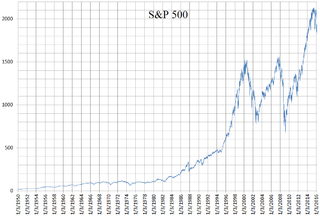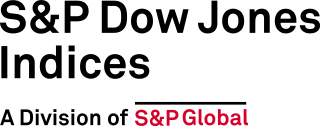
The Standard and Poor's 500, or simply the S&P 500, is a stock market index tracking the stock performance of 500 of the largest companies listed on stock exchanges in the United States. It is one of the most commonly followed equity indices and includes approximately 80% of the total market capitalization of U.S. public companies, with an aggregate market cap of more than $43 trillion as of January 2024.
Dow Jones is a combination of the names of business partners Charles Dow and Edward Jones.
The Global Industry Classification Standard (GICS) is an industry taxonomy developed in 1999 by MSCI and Standard & Poor's (S&P) for use by the global financial community. The GICS structure consists of 11 sectors, 25 industry groups, 74 industries and 163 sub-industries into which S&P has categorized all major public companies. The system is similar to ICB, a classification structure maintained by FTSE Group.

The S&P Europe 350 Index is a stock index of European stocks.
The S&P Global 100 Index is a stock market index of global stocks from Standard & Poor's.
The S&P/TSX 60 Index is a stock market index of 60 large companies listed on the Toronto Stock Exchange. Launched on December 30, 1998 by the Canadian S&P Index Committee, a unit of S&P Dow Jones Indices, the index has components across nine sectors of the Canadian economy. The index forms the S&P/TSX Composite Index alongside the S&P/TSX Completion Index, as well as being the Canadian component of the S&P Global 1200.
The S&P/ASX 50 Index is a stock market index of Australian stocks listed on the Australian Securities Exchange from Standard & Poor's.
The S&P Latin America 40 is a stock market index from Standard & Poor's. It tracks Latin American stocks.
The S&P 100 Index is a stock market index of United States stocks maintained by Standard & Poor's.

The Dow Jones Global Titans 50 index is a float-adjusted index of 50 of the largest and best known blue chip companies traded on the New York Stock Exchange, American Stock Exchange, Nasdaq, Euronext, London Stock Exchange, and Tokyo Stock Exchange. The index represents the biggest and most liquid stocks traded in individual countries. It was created by Dow Jones Indexes to reflect the globalization of international blue chip securities in the wake of mergers and the creation of megacorporations.
SPDR funds are a family of exchange-traded funds (ETFs) traded in the United States, Europe, Mexico and Asia-Pacific and managed by State Street Global Advisors (SSGA). Informally, they are also known as Spyders or Spiders. SPDR is a trademark of Standard and Poor's Financial Services LLC, a subsidiary of S&P Global. The name is an acronym for the first member of the family, the Standard & Poor's Depositary Receipts, now the SPDR S&P 500 Trust ETF, which is designed to track the S&P 500 stock market index.
The S&P/ASX 300, or simply, ASX 300, is a stock market index of Australian stocks listed on the Australian Securities Exchange (ASX). The index is market-capitalisation weighted, meaning each company included is in proportion to the indexes total market value, and float-adjusted, meaning the index only considers shares available to public investors.

S&P Dow Jones Indices LLC is a joint venture between S&P Global, the CME Group, and News Corp that was announced in 2011 and later launched in 2012. It produces, maintains, licenses, and markets stock market indices as benchmarks and as the basis of investable products, such as exchange-traded funds (ETFs), mutual funds, and structured products. The company currently has employees in 15 cities worldwide, including New York, London, Frankfurt, Singapore, Hong Kong, Sydney, Beijing, and Dubai.
The S&P MidCap 400 Index, more commonly known as the S&P 400, is a stock market index from S&P Dow Jones Indices.
The Dow Jones Sustainability Indices (DJSI) launched in 1999, are a family of indices evaluating the sustainability performance of thousands of companies trading publicly, operated under a strategic partnership between S&P Dow Jones Indices and RobecoSAM of the S&P Dow Jones Indices. They are the longest-running global sustainability benchmarks worldwide and have become the key reference point in sustainability investing for investors and companies alike. In 2012, S&P Dow Jones Indices was formed via the merger of S&P Indices and Dow Jones Indexes.

In finance, a stock index, or stock market index, is an index that measures the performance of a stock market, or of a subset of a stock market. It helps investors compare current stock price levels with past prices to calculate market performance.
The S&P SL20, or the Standard & Poor's Sri Lanka 20, is a stock market index, based on market capitalization, that follows the performance of 20 leading publicly traded companies listed in the Colombo Stock Exchange. The 20 companies that make up the index is determined by Standard & Poor's global index methodology, according to which the index's listing is reviewed each year. All S&P SL20 listed stocks are classified according to S&P and MSCI's Global Industry Classification Standard, thereby enabling better comparison of performance of Sri Lanka's largest and most liquid stocks with other global indices.
The communication services sector reshuffle is a reorganisation of the S&P 500 Index services centre in the United States. It took place on September 21, 2018.





